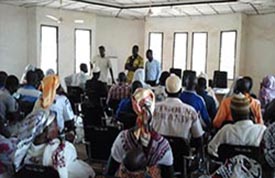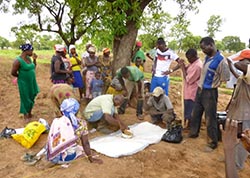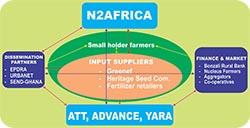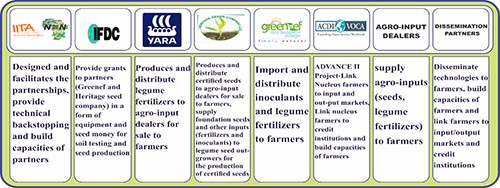Samuel Adjei Nsiah selected this article because our partnership has resulted in the development of a special fertilizer blend for grain legume crops in Ghana. Besides, this fertilizer blend has been adopted by the Ministry of Food and Agriculture in Ghana for use in the production of soyabean in Ghana within the framework of the government flagship program “Planting for Food and Job”. This is also a landmark achievement because for the first time in Ghana, legume fertilizer has been included in the government’s fertilizer subsidy program in Ghana. This article first appeared in Podcaster 44, February and March 2017.
|
Grain legume production in northern Ghana is characterized with low yields due to declining soil fertility, inadequate use of farm inputs and lack of good quality inputs including certified seeds, phosphorus fertilizers and rhizobium inoculants. The international Institute of Tropical Agriculture (IITA-N2Africa) has designed and facilitated a multi-stakeholder partnerships with 14 of its partners with the aim of enhancing technology dissemination and scaling up, building capacity of smallholder farmers and other actors and promoting sustainable input supply and output market. |
Diagrammatic representation of input distribution and marketing of soyabean model |
|
|
Responsibility chart of the actors in the N2Africa Soyabean-PPPs model in Ghana |
Outcomes and lessons learnt:
- Multi-stakeholder workshop on sustainable input supply and output markets enhanced and facilitated the design, coordination and implementation of the PPPs;
- Joint on-farm trials with inputs suppliers created awareness of need, demand and market for legume fertilizers (e.g. involvement of YARA in fertilizer trials);
- Farmers access to legume fertilizers enhanced, and market for legume fertilizers in northern Ghana created. According to the manager of YARA fertilizer depot in northern Ghana, sales of legume fertilizer increased from about 15 tons in 2015 to more than 200 tons in 2016;
- General collaboration and Business relationships among the partners strengthened (e.g. Greenef and Heritage seed).
 |
 |
Photos: Soyabean technology dissemination activities in Yendi, Ghana |
Conclusion and way forward
- Packaging of fertilizers in smaller quantities (e.g. 25 kg instead of 50 kg) to meet the needs of farmers who cannot afford the price of the 50 kg bags;
- Improve on the system of quantification and accuracy of input demand information to enable suppliers meet the demand of farmers;
- Strengthen the capacity of inputs suppliers to meet different demands of their clients.
Samuel Adjei-Nsiah, Country Coordinator Ghana
|
Testimony of success on collaboration between YARA and N2Africa through the PPP in northern Ghana Our collaboration with N2Africa started when N2Africa through the ADVANCE Project sought to compare the yield of inoculated soyabean with uninoculated soyabean and also with inoculated soyabean and phosphorus fertilizer. YARA therefore decided to develop a nutrition solution for legumes. We however realized that this will not be successful without important actors with similar interest like N2Africa. This is how we started collaborating with IITA. First, IITA made a request to YARA to make available TSP at its depot in Tamale for trial purposes. However, we decided to include other P fertilizers in the trial. IITA then requested to make TSP available in the retail shops in some farming communities for sale to farmers for their legume crops. It was not easy for us to accept this request because first TSP is an important raw material for the production of other fertilizers and we also felt that it is an expensive fertilizer and not within the reach of average farmer and finally YARA believes TSP is not balanced enough nutritionally for the legume. However with persistence from IITA through the coordinator, YARA obliged and made available the TSP fertilizers through its distribution channels in some selected locations accessible to farmers. The distribution channels included the following:
Through this arrangement we were able to sell more than 200 tons of TSP in 2016 compared with less than 15 tons sold in 2015. Milestones achieved include:
Mr. Mahama Abdul-Rahaman, YARA Marketing Manager |


